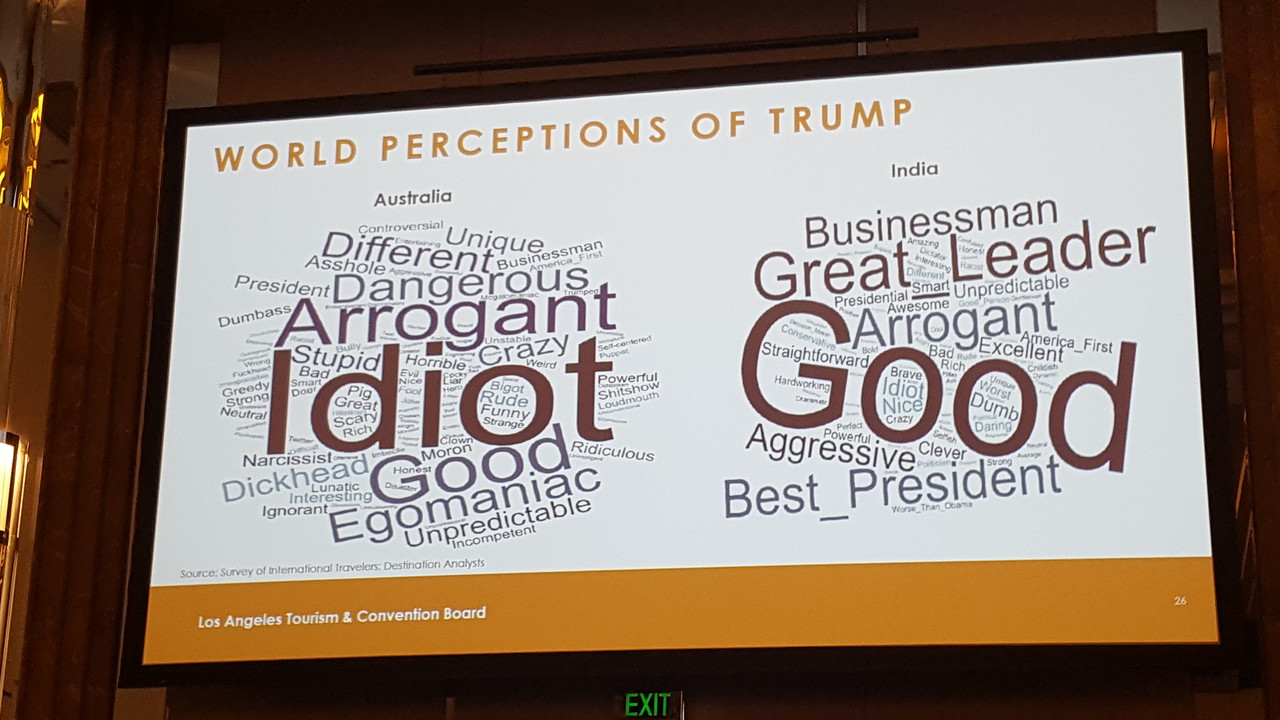11th July 2019 By Contributor
 An excerpt from a presentation by Wendy Kheel, Los Angeles Tourism & Convention Board. Image: Carolyn Parker
An excerpt from a presentation by Wendy Kheel, Los Angeles Tourism & Convention Board. Image: Carolyn Parker
“We need a Greta Thunberg of tourism” suggested a keynote speaker at the Travel and Tourism Research Association International Conference. The ritzy end of Melbourne’s Collins Street was a curious backdrop to the challenges laid out to tourism researchers from around the world, writes Angus & Associates’ Carolyn Parker.

Carolyn Parker
The Travel and Tourism Research Association (TTRA) International Conference held at the end of June and hosted for the first time by the organisation’s Asia Pacific chapter was an event that set out to explore ‘shifting sands – tourism research in changing times’.
As a first time attendee, the event was notable to me for the sense of community (“you’ll feel like you’ve come home” I was advised by an Australian peer). Representing around thirty countries, delegates generally faced the same research challenges and had much to share with, and learn from, each other. Event evaluations facilitated by Visit North Carolina are in essence the same as those Angus & Associates’ conducts here in New Zealand. At lunch, I sat next to an academic who studied an event in Europe that we also studied when it came to New Zealand as part of its’ world circuit. In Japan, they are researching the effect of different messages about introducing an accommodation tax in a mountain village (turns out the message makes no difference – what does is the past experience of visitors in paying accommodation taxes, and their loyalty to the destination).
The event brought together academic and practitioner researchers from around the world. The delegate list comprised a small contingent from New Zealand and representatives from destination marketing and management organisations, government officials, academics and commercial researchers and consultants (think Travel Portland, Statistics Canada, Visit Guam, Griffith University, and Destination Analysts).
Historically a North American centric group, TTRA in recent years has taken steps to be a truly international association, bringing the International Conference ‘down under’ a very practical step in delivering on this mission. Although, the Grand Hyatt at the glitzy ‘Paris End’ of Melbourne’s Collins Street, bursting with Louis Vuitton, Bvlgari, Prada, Hermes, Dolce & Gabbana-type boutiques, in some ways felt like it could be any number of places around the world.
As we’re starting to see in New Zealand, destinations are exploring the use of big data to complement more traditional data sources. The feeling was, however, that traditional data will retain an important role. We learnt about the process of establishing International Visitor Surveys in several Pacific Island nations from the International Finance Corporation, and about options for measuring Airbnb-type activity from AirDNA. We were also challenged by the view of some that visitor numbers are ultimately a vanity metric – these delegates suggested that it’s the value of visitors (in all senses of the word) that really matters.
Also of interest was research used to assist destinations facing challenging circumstances. The Los Angeles Tourism and Convention Board took us through research they conducted to inform and evaluate their Everyone is Welcome initiative, launched in response to negative sentiment towards the US (for the marketing gurus among you check out L.A. Tourism’s stunt to create one of the world’s largest, human-powered welcome signs – done in the flight path of LAX). Lorraine Taylor from Colorado talked with me about her work researching the role of the local tourism organisation in the recovery of the tourism industry from the Gold King Mine Spill (and having looked at situations New Zealand tourism organisations have faced in recent years as part of this).
How to achieve sustainability in terms of the access of visitors to unique and important places was a theme that emerged in multiple ways – visitation of Tane Mahuta here in New Zealand was discussed, as was access to Hawaiian waterfalls, remote villages in the Solomon Islands, and Aboriginal lands in Victoria set to become a world heritage site. We were challenged with considering how tourism research can best serve these places and those connected to the land so that sustainable solutions are found.
So where did we end up with our ‘shifting sands’? We were challenged to be brave with big data (but were also cautioned that some opportunities may die as consumers reject tracking activity); we were urged not to ignore the seniors market (many have been in the ‘dreaming’ phase of their trip for 30-40 years, and they’re excited!); to consider how we might think differently if we considered visitors to rather be short-term residents; and that for some popular sites enforced ‘rest periods’ would likely be very beneficial (but potentially problematic for those trying to address seasonality issues). Let’s just say the sands continue to shift!
This column was republished from LinkedIn with permission from the author and Angus & Associates‘ research director, Carolyn Parker.